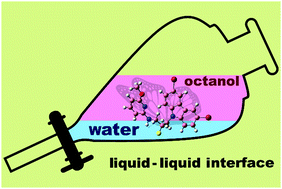当前位置:
X-MOL 学术
›
New J. Chem.
›
论文详情
Our official English website, www.x-mol.net, welcomes your
feedback! (Note: you will need to create a separate account there.)
Impact of the chemical structure on the distribution of neuroprotective N-alkyl-9H-carbazoles at octanol/water interfaces†
New Journal of Chemistry ( IF 2.7 ) Pub Date : 2019-12-12 , DOI: 10.1039/c9nj04251b Maryam Heydari Dokoohaki 1, 2, 3, 4 , Amin Reza Zolghadr 1, 2, 3, 4 , Axel Klein 1, 2, 3, 4, 5
New Journal of Chemistry ( IF 2.7 ) Pub Date : 2019-12-12 , DOI: 10.1039/c9nj04251b Maryam Heydari Dokoohaki 1, 2, 3, 4 , Amin Reza Zolghadr 1, 2, 3, 4 , Axel Klein 1, 2, 3, 4, 5
Affiliation

|
All-atom molecular dynamics (MD) simulations were performed to systematically analyse the distribution and agglomeration of a series of small neuroprotective N-(3-anilinopropyl)-9H-carbazole based molecules at octanol/water interfaces along with a detailed assessment of their structural and dynamical properties, such as density profiles, distribution functions, average orientations, hydrogen bonding (H-bonding), and mean-square displacements. Our simulations show that the biologically active neuroprotective molecules easily migrate from the water phase to the octanol phase during the simulation trajectories. However, biologically inactive derivatives agglomerated in the water phase. Calculated radial distribution functions (RDFs) clearly underpin the necessity of the two 3,6-dibromo substituents on the carbazole core for a sufficient hydrophobic character. Furthermore, we could show that H-bonding from F, or OH groups located on the propyl unit with octanol or water molecules are decisive structural requirements for their distribution between the two liquid phases.
中文翻译:

化学结构对辛醇/水界面神经保护性N-烷基-9 H-咔唑分布的影响†
进行全原子分子动力学(MD)模拟,以系统分析一系列小的神经保护性N-(3-苯胺基丙基)-9 H的分布和团聚-咔唑分子在辛醇/水的界面,以及对其结构和动力学性质的详细评估,例如密度分布,分布函数,平均方向,氢键(H键)和均方位移。我们的模拟表明,在模拟轨迹期间,具有生物活性的神经保护分子很容易从水相迁移到辛醇相。然而,生物惰性衍生物在水相中聚集。计算得到的径向分布函数(RDF)显然为咔唑核上两个3,6-二溴取代基提供了足够的疏水特性。此外,我们可以证明F的H键
更新日期:2020-01-10
中文翻译:

化学结构对辛醇/水界面神经保护性N-烷基-9 H-咔唑分布的影响†
进行全原子分子动力学(MD)模拟,以系统分析一系列小的神经保护性N-(3-苯胺基丙基)-9 H的分布和团聚-咔唑分子在辛醇/水的界面,以及对其结构和动力学性质的详细评估,例如密度分布,分布函数,平均方向,氢键(H键)和均方位移。我们的模拟表明,在模拟轨迹期间,具有生物活性的神经保护分子很容易从水相迁移到辛醇相。然而,生物惰性衍生物在水相中聚集。计算得到的径向分布函数(RDF)显然为咔唑核上两个3,6-二溴取代基提供了足够的疏水特性。此外,我们可以证明F的H键











































 京公网安备 11010802027423号
京公网安备 11010802027423号